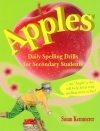Some students still struggle with spelling at junior and senior high levels either because of poor teaching or their own difficulty in recalling or applying spelling rules. While most resources for teaching spelling rules are targeted at younger students, Apples is written for older students. The title says "secondary students" but it will work equally well for junior high students.
Lessons each begin with presentation of a single spelling rule, called a "clue" in this book. After each clue are exercises that vary from lesson to lesson--exercises such as fill-in-the-blanks, circle the misspelled word and rewrite it correctly, and crossword puzzles. Exercises frequently include Scripture verses and Christian references.
This is not a comprehensive book covering all spelling rules. Rather, it focuses on those that cause the most problems for older students.
It covers rules such as whether or not to double final consonants when adding suffixes, usage of "your" and "you're, "ch" and "tch" endings, changing "y" to "i" and adding suffixes, ending syllables spelled with "tion" and "ture," "-ight" words, and more. Periodic review lessons are included.
Rules are restated at the beginning of subsequent lessons that continue work on the same concept—sometimes the next two or three lessons. In these subsequent lessons, the rule is presented with some blanks to be filled in by the student so that he or she has to think about or review the rule each time before beginning the exercises. There are also lessons to help students memorize words that don't follow rules (especially some long-vowel words).
Lessons should take about 10 minutes a day and Apples has lessons for 150 days. So one book should take about one school year to complete if you occasionally skip Apples. This is a consumable worktext, so each student will need his or her own copy.
While I like the concept of this book, I have concerns about one technique used frequently throughout the book: words are purposely misspelled by replacing letters with a phonetic substitute. Students are to correct the misspellings. For example, they are given a list of words spelled, "puncher, legislacher, furnicher, miniacher," and "literacher," and told to replace the "cher" with "ture." Or they are asked to do something similar with a sentence such as "The mother praied fervently, then spoke with honeied words, 'Had you obeied me, I would have enjoied taking you out for ice cream.'" For some students the visual image of the misspelled words imprints upon their brains making it very challenging for them to be able to see when words are misspelled. It confuses their visual memory. By junior high, parents usually have a good idea as to whether or not this is likely to be a problem for their child, but if this is the case with your child, Apples is probably not a good choice. For other students, working with misspellings that are common phonetic substitutions is very helpful.
Apples 2: Daily Phonics Drills for Secondary Students
Apples 2: Daily Phonics Drills for Secondary Students follows the same format with another 150 lessons. A number of rules (about one third) are repeated from the first book. In a number of instances, the exercises are identical or slightly altered from the first book. Because of this, I would not recommend using both books one year after the other. Nevertheless, Apples 2 adds some new rules and extra skills. Especially notable are check-writing activities and envelope exercises that help students learn how to write out numbers (as on checks) and the correct format for addresses. Among the new spelling rule challenges are those dealing with the "au" sound; the choice between "ous, cious," and "tious;" and the choice between "ance" and "ence."









